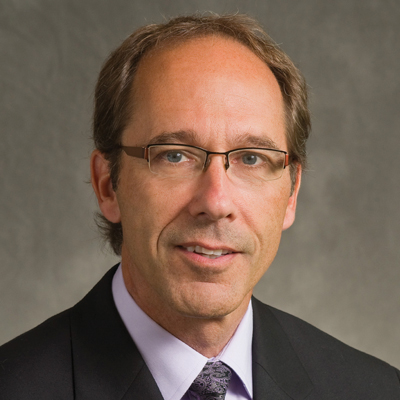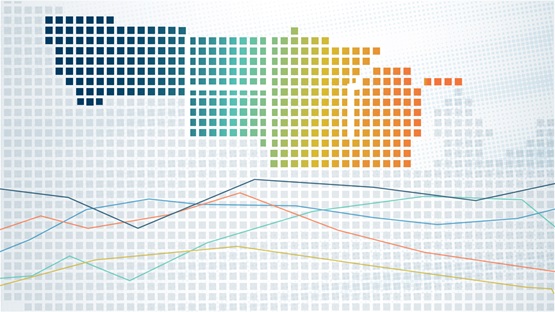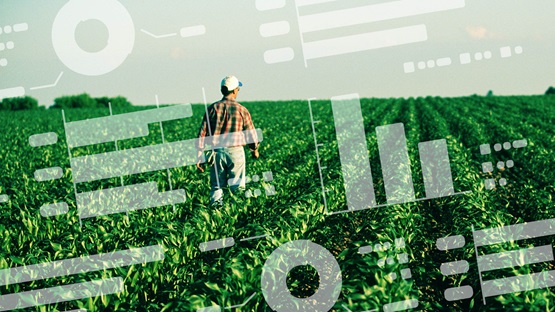Interview conducted June 3, 2010
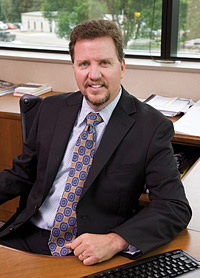
Eric Hardmeyer was named president of the Bank of North Dakota in 2001. A native of Mott, N.D., he began his 25 years of service with BND as a loan officer.
The Bank of North Dakota operates primarily through lending partnerships with other financial institutions in the state. It opened in 1919 with $2 million in capital and today has more than $270 million in capital. The state of North Dakota began using bank profits in 1945 when money was first transferred into the general fund, and such transfers have become the norm to augment state revenues.
BND reported record growth and profits in 2009. Net earnings increased to $58 million, and total bank assets grew to $3.9 billion.
BND is overseen by the North Dakota Industrial Commission (of which the governor is chair) as well as an advisory board of directors, which reviews BND operations and makes recommendations to the Industrial Commission concerning management, services, policies and procedures.
For more information, go to http://www.banknd.nd.gov/.
fedgazette: The nation’s banking crisis and the recession have brought the Bank of North Dakota into the spotlight. Media reports suggest that numerous states are looking at BND as a possible model for their own state. Roughly speaking, how many official and unofficial queries have you fielded?
Hardmeyer: I would say anywhere from 15 to 25 in terms of states, but we’ve had interest from all over the globe, including Germany, Japan and Spain.
fedgazette: We didn’t realize you were receiving foreign inquiries too. What’s been the nature of their interest?
Hardmeyer: Of course, they’re looking at the United States’ response to the recession and to the various state economies around the country. North Dakota is one of those states that have been particularly stellar in light of the national economic issues. They’ve also looked a little deeper to see what is unique about North Dakota and found that we have a state-owned bank, and so that has led to these inquiries and interest.
fedgazette: And that’s certainly why you’ve received interest from various states. How would you characterize the seriousness of these state queries?
Hardmeyer: I would say that there are anywhere from three to five states that are in various stages of investigation, perhaps putting together contemplative legislation to look at the idea. The most work that I’ve seen done on the subject is by the state of Vermont. They’ve done a pretty interesting study on this state-owned bank and the impact that a similar bank would have on Vermont.
fedgazette: Other states that are considering such a bank must ask you about the reaction of private lenders to having a state-owned player in the field. How does the Bank of North Dakota ensure that it doesn’t squeeze out profit opportunities for private lenders?
Hardmeyer: We’re very sensitive to that issue. If you go back to the operating policies that were established when the bank was founded, it was always the imperative that the Bank of North Dakota do nothing harmful to the private sector banks and that it is here to partner rather than to compete with them. We get that; we understand that. And we are constantly looking to ensure that we have a balance between meeting our mission and not infringing upon the opportunities of the private sector. It’s one of those things that are just ingrained in how we do business.
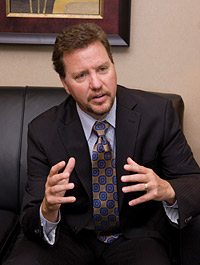
We have a very solid relationship with both of the banking associations in North Dakota—the North Dakota Bankers Association and the Independent Community Banks of North Dakota. We serve on their boards in different capacities, and I think you would find from their executives that the relationship between the Bank of North Dakota and the community banks and system banks here is solid. We know our role and play it to the best of our abilities.
One thing that people need to understand about the bank is that in addition to the mission-critical things that we do, we’re also a banker’s bank. So, to access our programs, you would have to work through a local originating bank. There is very little opportunity [for a consumer] to come directly to the Bank of North Dakota for any loan activity. The area where we did compete is student loans. However, beginning July 1, 2010, the bank-delivered student loan program known as the FFELP [Federal Family Education Loan Program] will be eliminated and run by the federal government. And even in that area, we had formed alliances with banks across the state to work with them.
North Dakota banks understand that we really are not set up to compete with them and that our programs are delivered through them. We also provide great value to banks in terms of providing liquidity when they have needs; or, if they have excess liquidity, we are a market for fed funds. We do a lot of typical things that you would get from a correspondent bank.
fedgazette: Let’s take a step back for a moment. What’s the main advantage of having a state-owned bank? Put another way—what is the credit market gap that such a bank fills?
Hardmeyer: We deliver a number of economic development programs, and I think a lot of other states may do things similar to what we do, but through other vehicles like an economic development corporation or some sort of authority. We have a strong and growing deposit base that we can fund those things directly from. Consequently, we did not have a funding issue that some state authorities had when the capital markets seized up.
It’s always about looking at how we can fit into the state’s strategy of diversifying and generating new wealth for the state and expanding what we have. We work closely with the North Dakota Department of Commerce, governor’s office, the agriculture commissioner’s office, the economic development community and the banking community to see what we can do to help spur economic development. We believe that it all begins locally. It shouldn’t be driven from the top down; it should be driven from the bottom up. We’re there to support those functions, not to lead them.
The questions that I ask a state when it queries about BND is—what do you want a state-owned bank to be? What do you want it to do? Do you want it to be a small-business lender? Some say that they’re having a tremendous problem with their budget and they’re looking for ways to plug some holes, and they believe a state-owned bank could help alleviate part of the revenue problem given the revenue that we could generate. One of the other major themes is the one that you hit on with your question about the recession—there has been a lot of discussion of credit drying up for business owners. In one case, that is why they’re interested in a state-owned bank. They want to ensure that their business community has access to credit and can direct their state revenue to make it available to meet that end.
fedgazette: Getting back to something you addressed earlier. There seems to be some belief in a causal link between the presence of a state-owned bank and the North Dakota economy, which has been remarkably strong during the recession. What’s your take on that link?
Hardmeyer: I have tended to downplay that. The economy here in North Dakota has benefited tremendously from the energy resources that we have, certainly oil, natural gas, coal and wind energy—all things that are needed and are in great demand around the country, and we have an abundance of those. We also have a fairly diversified economy; agriculture has certainly been good the last three or four years. We’re playing to our natural strengths here, agriculture and energy.
BND has programs that have benefited business owners and farmer/ranchers. And we’ve certainly aided the banking community in times of stress. We have 100 banks in the state, with a population of 650,000. One of the conclusions of the Vermont study was that the Bank of North Dakota helps strengthen and makes for a vibrant community bank network, and I would concur with that.
I think that we’ve played a significant role in the state’s recent success, but to quantify a role and tell you what that is would be difficult. But certainly to lay the success of the state’s economy at our feet wouldn’t be appropriate either. We’re a player.
fedgazette: North Dakota has a long political history that mixes populist radicalism with strong conservatism. In certain respects, it is surprising that a state like North Dakota has an institution that many brand as socialist, especially in 2010. How do people square this seeming dichotomy? Do you think that a state-owned bank is something that North Dakota would create today?
Hardmeyer: That’s true, but of course you have to go back 91 years or so when the bank was created and look at it from that point of view. The Progressive movement was sweeping the country; there was an angry agrarian movement that believed that most of the decisions being made about issues important to North Dakota were made for us, and not by us.
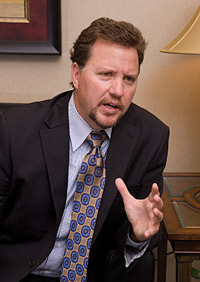
What’s interesting to me is that some of those same kinds of issues are popping up again. In 1917 and 1918, when the bank was conceived, World War I was ending, there was a flu epidemic and there was a moderate recession followed by a much tougher one in 1920. You see some parallels between what’s happening in the country today versus back then. There was a lot of anger and fear. And then you square that up with today and you ask, could it happen today, in this state? I would say probably not because our political electorate is at a different point in their social philosophy. But what is very interesting when you go back and look at the original operating policies, the one thing the creators of BND understood is that it was important to fix in the minds of the citizens of North Dakota what this institution was and what it was going to do.
I think North Dakotans have realized over the bank’s history that there is utility and benefits that this bank can provide, whether it’s financing economic development opportunities or its ability to assist in dealing with natural disasters or other critical needs. For example, we were front and center after the Grand Forks flood of 1996–97 and have been an important player in addressing disasters that affect the agricultural community. Another example is the unique financing needs brought on by the energy boom going on in western North Dakota. So it’s finding the gaps and filling them, and I think that North Dakotans realize that we can move nimbly and quickly to help fill those gaps and that we are willing to do that.
fedgazette: How has the Bank of North Dakota fared during the recent financial crisis and recession? How does the bank ensure that it doesn’t get caught up in situations that put it at risk? Is the bank guaranteed by the state of North Dakota? That is, can it fail? Is it too big or too important or too political to fail?
Hardmeyer: The bank is very sound financially. Our loan portfolio is a reflection of what’s happening statewide. Overall, the health is good, but we are starting to see some things trickle into the statewide numbers. The national recession is having an impact, and you would expect that to happen as you see this thing play out. Our economy is stronger than most right now, and the banking community by and large is still solid.
If you look at the banking community, you’ll see that there are some struggles there, but not to the extent that you’ve seen it in other states. The Bank of North Dakota’s exposure outside of the state is limited, which is probably good right now. Because of the unique nature of this institution’s mission, there will always be an element of risk that the private sector banks don’t have. However, our capital and reserve for loan losses are strong, and our loan portfolio is in good shape, so I don’t see that question as a critical issue.
fedgazette: When it comes to economic development needs in North Dakota, one issue that gets a lot of attention is the need for housing in western North Dakota, specifically in those communities affected by the increase in oil drilling. How is the Bank of North Dakota involved in trying to address that need?
Hardmeyer: We’ve recently met with officials from the Williston area where the housing problems seem to be the most acute. They’re struggling to keep ahead of their housing needs, and they’re really looking at the long-term implications for their community—what kind of housing stock they need and keeping in mind the history of previous boom-and-bust cycles. The local city officials and community bankers have gone at this with a very deliberate approach. Some in the community might argue too conservatively, but I wouldn’t.
We’ve worked with them to figure out ways in which the city can encourage development of single-family residential infrastructure. They want to work with the development community, whether it’s in-state developers or others from outside North Dakota, to put a package together that would [encourage] them to come and start building some housing stock. We’ve been working with the city of Williston to reduce their exposure to infrastructure needs—street, sewer, water lines, lighting, that kind of thing.
Now, there are still needs in other areas, whether it’s Stanley or Tioga or other high-impact areas with the central theme being: How permanent is this growth? You don’t want to overbuild for a temporary situation. Is it a seven- or a 10-year play, or is it a two-year play? What happens if oil drops to 30 [dollars per barrel]? There’s just a lot of caution out there about not repeating the mistakes that we made in the 1980s.
As local and state officials examine the issue, they realize that there is going to be a permanent need after this exploration phase is over. Oil wells will need to be serviced, and management of production will continue. Because of this, there is going to be some permanency to the labor force when the exploration phase is over. And that’s really the question—how do they build for that phase? Along with BND and other state agencies, the expectation is that they will also seek legislative assistance at the next session. Their needs are tremendous, particularly with regard to roads, housing and water issues.
fedgazette: Nice problems to have these days.
Hardmeyer: That’s right, and it’s interesting because I have been in this business for 25 years now, and I’ve watched the economy throughout the 1980s and 1990s struggle in a lot of these areas. In visiting with these developers, their issues are 180 degrees different from what they were 10 to 15 years ago. That feeling of desperation that we all seemed to feel when it came to rural North Dakota is gone and replaced with, “How do we keep up with this?”
I was just in China a couple of months ago with a delegation looking at a coal-to-liquids facility that they’ve built in inner Mongolia. That technology can play a big part in North Dakota’s economy in future years. With North Dakota’s 800-year supply of coal, the potential for the state now in regard to new coal technology is enormous. These are exciting times to be in North Dakota.
fedgazette: Thank you, Mr. Hardmeyer.
—David Fettig
